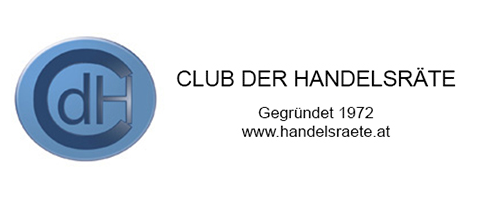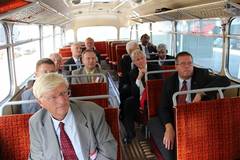ÖBB R&D
The first event after the summer break was a visit to the research and development division of the ÖBB (Austrian Federal Railways) Infrastructure Company.
Approximately 30 CdH members gathered in the atrium of the new Austrian Federal Railways (ÖBB) infrastructure headquarters building at Wien Praterstern 3, where they were received by the head of the ÖBB R&D business unit, Ing. Wolfgang Zottl. From there, the delegates were taken up to a conference room where they were formally welcomed by CdH President, Ron Willis, and by Ing. Zottl.
Then followed a series of presentations describing the business unit and its current activities:
Keeping rail transport safe, comfortable, efficient and effective
Ing. Zottl explained how his business unit is positioned within the Infrastructure division of the ÖBB, and that it is a strategic element in the corporate structure of the parent company. The goal of the organisation is to handle research projects aimed at consolidating the strategic position of the ÖBB and strengthening it, technically and commercially, as a modern and environmentally-friendly railway system. The unit's activities extend into regional, national and international research projects. It has 15 employees, an annual budget of euros 5 million, and is currently handling around 60 different research projects.
The overall mobility solution
Mag. Katrin Schuster gave a presentation on "eMORAIL"; the integrated e-mobility service for public transport, combining travel by train with travel by electric car and bike. This project is based on the concept of people using the train to cope with the majority of the distance, and transferring to and from electric cars or electric bikes at railway stations. The logistics are managed via smart phone to offer the traveller as much scheduling flexibility as possible.
Bridges to order
The use of pre-fabricated elements to construct bridges was the topic of DI Andreas Schön's presentation entitled "New Bridge Construction using Semi-precast Concrete Elements". Here it was explained how the construction of bridges could be simplified, carried out more quickly and to more accurate dimensions, by having many of the structural elements pre-fabricated in the workshop and transported, semi-finished, to site. This can result in significant savings of both time and materials.
An insider's view
DI Dr. Michaela Haberler-Weber outlined a project entitled "Laserscanning for the Collection of Infrastructure Data". This concerns the acquisition of terrain profile dimensioning data to create manoeuvrable images and store dimensional data of railway alignments and of structural features / objects on and around the alignments. The data collection can be from airborne platforms or train-borne platforms, and the current system has a resolution of about 5 cm and can collect 10 GB of data per kilometre of track.
The challenge of the human element
"Level Crossings ? An Overview of Recent R&D" was the title of a presentation by Mag. Dr Günter Dinhobl. The problem of road users crossing the railway tracks at level crossings while the warning or barrier system indicates the approach of a train, is an ever continuing problem. In Austria there are currently about 100 level crossing accidents a year, resulting in around 20 deaths a year. To understand why road users behave as such, and how this could be prevented, is a continuing challenge for the railway industry.
Keeping track on the track
DDI Dietmar Maicz, of the company Hottinger Baldwin Messtechnik (HBM), gave the delegates an overview of the Argos wayside track monitoring system; a track-mounted system which can identify rolling stock and which senses and displays the dynamic behaviour of railway vehicles and their running gear components. Through this, anomalies can be highlighted to warn of potential failures of components and / or derailments.
Following the presentation session, those delegates who were interested in seeing the Argos equipment in action were taken by vintage bus, a Gräf & Stift 145-FON , one of the first buses used by the Postbus company in Austria in 1962, to the measuring site in Deutsch Wagram. Here the dynamic behaviour of a number of trains of various types which travelled past were observed by the visitors.
For the last part of the programme, the delegates were then taken to the renowned Marchfelderhof restaurant in Deutsch Wagram and treated to an excellent meal provided by their hosts.








